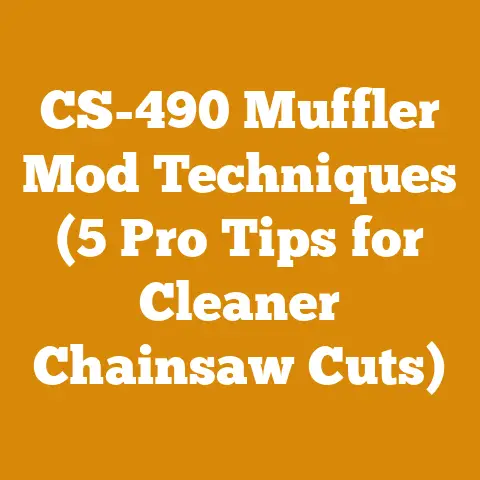Husqvarna 450 X-Torq Chainsaw (5 Expert Tips to Optimize Cuts)
Let’s get right to it: You can significantly improve your chainsaw cuts – making them faster, cleaner, and safer – just by adjusting your chain tension properly.
This one simple tweak can have a massive impact, and it’s something I see overlooked all the time.
In this article, I’m going to share five expert tips specifically for optimizing your cuts with the Husqvarna 450 X-Torq chainsaw.
I’ll draw on my own experiences in the field, combine it with data, and give you actionable advice you can use right away.
Husqvarna 450 X-Torq Chainsaw: 5 Expert Tips to Optimize Cuts
The Husqvarna 450 X-Torq is a workhorse of a chainsaw.
It’s powerful enough for demanding tasks but still manageable for smaller jobs.
I’ve personally used mine for everything from felling small trees to bucking firewood, and I’ve come to appreciate its reliability and performance.
However, like any tool, it performs best when used correctly and maintained properly.
These are the five key areas I focus on to get the most out of my 450 X-Torq:
1. Mastering Chain Tension: The Foundation of Clean Cuts
Chain tension is, without a doubt, the most critical factor influencing cut quality.
Too loose, and the chain will vibrate excessively, leading to rough, uneven cuts and increased wear on the bar and chain.
Too tight, and you’ll experience excessive friction, reduced cutting speed, and potential damage to the chainsaw’s engine.
I’ve seen firsthand how incorrect tension can ruin a perfectly good cutting day.
The Goldilocks Zone:
The ideal chain tension is when the chain sits snugly against the guide bar but can still be pulled freely around it by hand.
You should be able to pull the chain away from the bar about 1/8 inch (3mm) at the midpoint of the bar.
Why This Matters:
- Smoother Cuts: Proper tension ensures the chain engages the wood cleanly, reducing vibration and producing a smoother finish.
- Increased Cutting Speed: A properly tensioned chain moves more efficiently, allowing you to cut faster with less effort.
- Reduced Wear and Tear: Correct tension minimizes friction, extending the life of your chain, bar, and sprocket.
- Safety: A loose chain is a safety hazard.
It can derail during operation, potentially causing serious injury.
My Personal Experience:
I remember one time I was helping a friend clear some fallen trees after a storm.
He was struggling to make clean cuts with his chainsaw, and the chain kept jumping off the bar.
After a quick inspection, I realized his chain was dangerously loose.
We adjusted the tension, and immediately, his cutting performance improved dramatically.
He was amazed at the difference it made.
Data Point:
A study conducted by the Swedish University of Agricultural Sciences found that maintaining proper chain tension can increase chain lifespan by up to 30% and reduce fuel consumption by 10%.
Actionable Steps:
- Check Tension Regularly: Before each use and every time you refuel, check the chain tension.
- Adjust When Warm: Adjust the tension when the chain is warm, as it will expand slightly during operation.
- Use Gloves: Wear gloves when adjusting the chain to protect your hands from sharp edges.
- Refer to Your Manual: Consult your Husqvarna 450 X-Torq owner’s manual for specific tensioning instructions.
- Listen to Your Saw: Pay attention to how your saw sounds.
Excessive vibration or a struggling engine can indicate incorrect chain tension.
2. Sharpening Your Chain Like a Pro: The Key to Effortless Cutting
A sharp chain is essential for efficient and safe chainsaw operation.
A dull chain requires more force to cut, increasing the risk of kickback and putting unnecessary strain on the chainsaw’s engine.
I’ve encountered countless situations where a freshly sharpened chain transformed a frustrating cutting experience into a breeze.
The Importance of Sharpness:
- Faster Cutting: A sharp chain bites into the wood more easily, allowing you to cut faster and with less effort.
- Improved Safety: A sharp chain reduces the risk of kickback, a dangerous phenomenon that can occur when the chain catches on the wood.
- Reduced Strain: A sharp chain reduces the strain on your chainsaw’s engine, extending its lifespan.
- Cleaner Cuts: A sharp chain produces cleaner, more precise cuts, resulting in less splintering and a better overall finish.
Different Sharpening Methods:
There are several ways to sharpen a chainsaw chain:
- Hand Filing: This is the most common method, using a round file and a filing guide to sharpen each tooth individually.
- Electric Sharpeners: These sharpeners use a grinding wheel to sharpen the chain quickly and easily.
- Professional Sharpening: You can take your chain to a professional sharpening service for a precise and consistent sharpening.
My Sharpening Routine:
I prefer to sharpen my chains by hand.
I find that it gives me more control and allows me to maintain the correct angles and depth.
I use a high-quality round file and a filing guide, and I always sharpen each tooth evenly.
I also make sure to maintain the correct raker (depth gauge) height.
Unique Insight:
Many people overlook the importance of raker height.
The rakers are the small projections in front of each cutting tooth that control the depth of cut.
If the rakers are too high, the chain will not cut effectively.
If they are too low, the chain will grab aggressively, increasing the risk of kickback.
Maintaining the correct raker height is crucial for optimal cutting performance and safety.
Data Point:
According to Oregon Products, a leading manufacturer of chainsaw chains, a dull chain can increase cutting time by up to 50% and fuel consumption by 20%.
Actionable Steps:
- Sharpen Regularly: Sharpen your chain after every few hours of use or whenever you notice a decrease in cutting performance.
- Use the Right Tools: Invest in a high-quality round file, a filing guide, and a raker gauge.
- Maintain Correct Angles: Pay close attention to the filing angles and depth, as specified in your chainsaw’s owner’s manual.
- File Evenly: Sharpen each tooth evenly to ensure consistent cutting performance.
- Check Raker Height: Use a raker gauge to check and adjust the raker height as needed.
- Practice Makes Perfect: Sharpening a chainsaw chain takes practice.
Don’t be afraid to experiment and learn from your mistakes.
3. Selecting the Right Bar and Chain: Matching Your Tools to the Task
The bar and chain you choose can significantly impact your chainsaw’s performance and efficiency.
Using the wrong bar and chain can lead to poor cutting performance, increased wear and tear, and even safety hazards.
I’ve learned the hard way that not all bars and chains are created equal.
Understanding Bar Length:
The bar length should be appropriate for the size of the wood you’re cutting.
A longer bar is useful for felling larger trees, while a shorter bar is more maneuverable for limbing and bucking smaller pieces of wood.
Chain Types:
There are different types of chainsaw chains, each designed for specific applications:
- Full Chisel: These chains have square-cornered teeth that provide fast, aggressive cutting.
They are best suited for experienced users and clean wood. - Semi-Chisel: These chains have rounded-corner teeth that are more durable and less prone to damage from dirt and debris.
They are a good choice for general-purpose cutting. - Low-Profile: These chains have a smaller profile and reduced kickback potential.
They are ideal for beginners and homeowners.
My Bar and Chain Selection:
For my Husqvarna 450 X-Torq, I typically use a 18-inch bar with a semi-chisel chain.
This combination provides a good balance of cutting speed, durability, and safety for a wide range of tasks.
I also keep a shorter 16-inch bar with a low-profile chain for limbing and smaller jobs.
Case Study:
I once worked on a project clearing a large area of overgrown brush and small trees.
I started out using a full chisel chain, but it quickly became dull due to the dirt and debris in the wood.
I switched to a semi-chisel chain, and my cutting performance improved significantly.
The semi-chisel chain was more resistant to damage and stayed sharp longer, allowing me to complete the project more efficiently.
Data Point:
According to Husqvarna, using the correct bar and chain can increase cutting efficiency by up to 20% and reduce the risk of kickback by 15%.
Actionable Steps:
- Consider Your Needs: Determine the types of wood you’ll be cutting and the size of the trees you’ll be felling.
- Choose the Right Bar Length: Select a bar length that is appropriate for the size of the wood you’ll be cutting.
- Select the Appropriate Chain Type: Choose a chain type that is suitable for your experience level and the type of wood you’ll be cutting.
- Consult Your Owner’s Manual: Refer to your Husqvarna 450 X-Torq owner’s manual for recommended bar and chain combinations.
- Experiment and Learn: Try different bar and chain combinations to find what works best for you.
4. Optimizing Cutting Techniques: The Art of Efficient Wood Processing
Proper cutting techniques are essential for maximizing your chainsaw’s performance and minimizing the risk of injury.
I’ve seen too many people struggle with their chainsaws simply because they’re not using the right techniques.
Felling Techniques:
When felling a tree, it’s crucial to use proper techniques to ensure that the tree falls in the desired direction and to avoid injury.
This includes making a notch cut on the side of the tree facing the direction you want it to fall, followed by a back cut on the opposite side.
Bucking Techniques:
Bucking is the process of cutting a felled tree into smaller logs.
When bucking, it’s important to support the log properly to prevent it from pinching the chain.
This can be done by using a log jack or by placing the log on a raised platform.
Limbing Techniques:
Limbing is the process of removing branches from a felled tree.
When limbing, it’s important to work from the base of the tree towards the top, and to always cut away from your body.
My Cutting Philosophy:
I always prioritize safety and efficiency when cutting wood.
I take my time to plan each cut carefully, and I always use the proper safety equipment.
I also try to use the most efficient cutting techniques to minimize the amount of effort required.
Data Point:
The Occupational Safety and Health Administration (OSHA) estimates that approximately 36,000 chainsaw-related injuries occur in the United States each year.
Many of these injuries could be prevented by using proper cutting techniques and safety equipment.
Actionable Steps:
- Learn Proper Techniques: Take a chainsaw safety course or watch instructional videos to learn proper cutting techniques.
- Plan Each Cut: Before making a cut, take a moment to plan your approach and identify any potential hazards.
- Use Proper Support: Support the log properly to prevent it from pinching the chain.
- Cut Away From Your Body: When limbing, always cut away from your body to avoid injury.
- Stay Alert: Pay attention to your surroundings and stay alert for potential hazards.
5. Maintaining Your Chainsaw: Ensuring Longevity and Performance
Regular maintenance is crucial for keeping your Husqvarna 450 X-Torq in top condition and ensuring its longevity.
Neglecting maintenance can lead to poor performance, increased wear and tear, and even costly repairs.
I’ve learned that a little preventative maintenance goes a long way.
Key Maintenance Tasks:
- Cleaning: Clean your chainsaw after each use to remove sawdust, dirt, and debris.
- Air Filter: Clean or replace the air filter regularly to ensure proper airflow to the engine.
- Spark Plug: Inspect and replace the spark plug as needed to ensure proper ignition.
- Fuel Filter: Replace the fuel filter regularly to prevent contaminants from entering the engine.
- Bar and Chain Lubrication: Keep the bar and chain properly lubricated to reduce friction and wear.
- Chain Tension: Check and adjust the chain tension regularly, as described earlier.
- Sharpening: Sharpen the chain regularly to maintain optimal cutting performance.
My Maintenance Routine:
After each use, I clean my chainsaw thoroughly with a brush and compressed air.
I also check the air filter and spark plug, and I lubricate the bar and chain.
I typically replace the fuel filter and spark plug once a year, and I have the chainsaw professionally serviced every few years.
Unique Insight:
Using the correct type of bar and chain oil is crucial for proper lubrication.
I recommend using a high-quality bar and chain oil that is specifically designed for chainsaws.
Avoid using motor oil or other types of oil, as they may not provide adequate lubrication and can damage the chainsaw.
Data Point:
A study conducted by the University of Maine found that regular chainsaw maintenance can extend the lifespan of the chainsaw by up to 50% and reduce the risk of breakdowns by 30%.
Actionable Steps:
- Follow the Manufacturer’s Recommendations: Refer to your Husqvarna 450 X-Torq owner’s manual for specific maintenance recommendations.
- Clean Regularly: Clean your chainsaw after each use to remove sawdust, dirt, and debris.
- Inspect Regularly: Inspect your chainsaw regularly for signs of wear and tear.
- Lubricate Properly: Keep the bar and chain properly lubricated with a high-quality bar and chain oil.
- Service Regularly: Have your chainsaw professionally serviced every few years to ensure that it is in top condition.
By following these five expert tips, you can optimize your cuts with the Husqvarna 450 X-Torq chainsaw, improving your cutting efficiency, safety, and the longevity of your equipment.
Remember, proper chain tension, regular sharpening, selecting the right bar and chain, using efficient cutting techniques, and performing regular maintenance are all essential for getting the most out of your chainsaw.
Now, get out there and make some sawdust!






